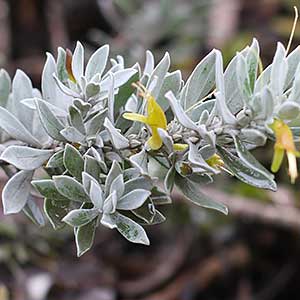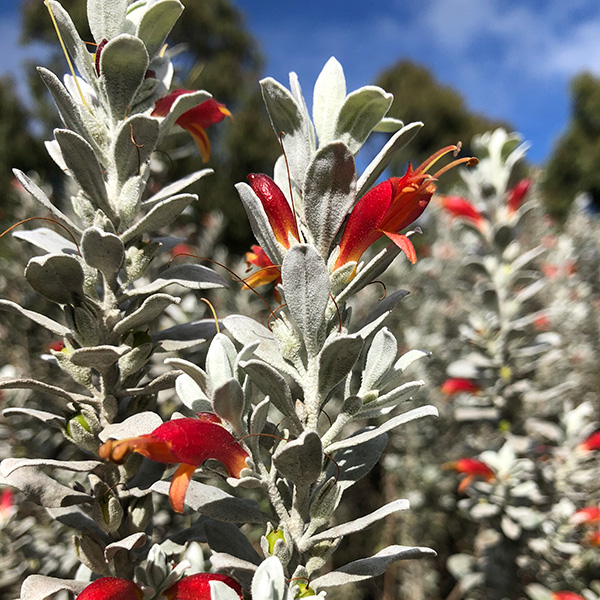
Variable in growth habit and flower colour, Eremophila glabra is commonly called the Tar Bush. Foliage is usually of a grey green colour and flowers from Yellow to Orange.
Eremophila glabra Growing and Care
Although varieties do differ, general care instructions are similar, the following is a guide line.
- Soil
The natural soil is a sandy alkaline soil, however as long as the soil is free draining this is not a fussy plant and it will grow in dry soils. - Sun/Light
Best grown in full to a little shade. Deep shade will give a less dense growth habit. - Watering
In dry summer periods water well and then let the soil dry before watering again,
A deep wood chip or arborists mulch is best and this can be applied each spring as needed.
Water once a week through the first summer after planting. - Pruning
The best time to prune is in spring to early summer. And after pruning is the best time to fertiliser. - Fertiliser
Use a specialist Australian Native plant fertiliser slow release is best. Again apply in spring.
Planting Eremophila glabra
- Plant in a sunny Position
- Choose a well drained soil, or mound up the soil to improve drainage.
- Water after planting and lightly mulch.
- Prune lightly directly after flowering to maintain a bushy habit and encourage more flowering shoots.
Varieties

- The variety E. glabra subsp. tomentosa is a favourite, attractive grey green foliage with good deep orange to red flowers. It will reach around 1.5 metres in height and is a haven for nectar seeking birds.
- E.glabra ‘Kalbarri Carpet’ is a low growing form as the name suggests, reaching only around 20 cm in height and with yellow flowers. Again a magnet for Bees, Butterflies and Birds.
- E. Glabra Roseworthy has foliage more on the green side, it is easier to grow than some others, Orange to red flowers low growing to around .5 metre and spreading to 1.5 metres.
- E.glabra prostrate form. This is one of the best ground cover forms. A natural dense habit, blue grey foliage and well suited for growing as a low border in a sunny position and a in a well drained soil.
- E. glabra ‘Murchison Magic’ pictured right has attractive orange flowers.
Summary Information
- Botanical Name – Eremophila glabra
- Common Names – Tar Bush, Fuchsia Emu Bush
- Position – Full Sun
- Soil – Well drained.
- Height – Variable from .2metre to 3 metres
- Spread – Variable from 1 metre to 2 metres.
- Flowers – Vary from Yellow to Orange and Brown.
- Flowering time – Autumn to Summer.
- Foliage – Lanceolate and with fine hairs.
- Growth Rate – Medium
- Frost tolerant – Medium
- Drought tolerant – Yes
